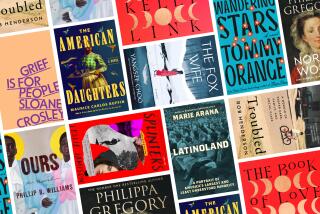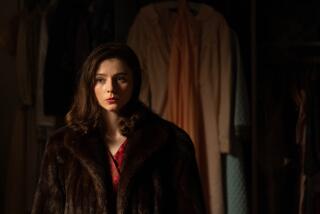PERSPECTIVE ON ‘MIDDLEMARCH’ : A Heroine in a Whole New Light : George Eliot’s story affirms that women may find themselves at the peak of their powers in the Flaming 50s.
You’ll never guess what is on the top of the bestseller lists in England--”Middlemarch” by George Eliot--a huge 19th-Century novel of provincial life in the Victorian era. Now PBS is gambling that the American public will embrace the remarkable BBC adaptation that began last night on PBS’ “Masterpiece Theatre.” When it aired in England last fall, it caused one-quarter of the population to cancel dinner plans and stay home to watch the series. But who is George Eliot, and what relevance does she have to women today?
Marian Evans--alias George Eliot-- refused to marry until she was middle-aged, living an independent existence as a journalist and novelist until she found a “second spring” with an already married man--George Henry Lewes, a literary giant in his own right-- with whom she lived openly in defiance of that rigid society. Theirs was not a passionate or romantic love, but one committed to the duty of literature.
She took a man’s name as a protective pseudonym. By the time she wrote “Middlemarch,” her knowledge of science, philosophy, history and four languages--but most important of the inner psychological truths of the human heart --had earned her the regard of Dickens, Trollope, Congreve and all Europe.
I was intrigued to learn that Eliot turned 50 just as she was beginning “Middlemarch.” It made me sympathetic and curious: Since 50 has been historically the age when women go through the passage of menopause, what impact might that have had on her masterwork? The Victorians were obsessed with women as reproductive creatures; 19th-Century obstetricians taught that “the change of life unhinges the female nervous system and deprives women of their personal charm.”
Up against that prescription George Eliot started off with her usual fanatical discipline. “I mean to begin my novel at once,” she wrote to her editor in February, 1869: But progress on the novel soon lapsed--why?
She and Lewes had been living happily together for more than 10 years. But Eliot’s plan to write a novel about her hero--Dr. Lydgate, a man of science and the future--was interrupted by a trip to Rome with her unlawful husband. Lewes was suffering from strange neurological symptoms and unable to get on with his own great work. Her brother was dying. Soon after her 50th birthday, Eliot wrote: “I have a deep sense of change within. And I have a permanently closer companionship with death.”
The couple’s fitful wanderings continued around Europe, while the writing of “Middlemarch” languished. Her husband wrote, “We are in a vacillating state of mind as to the arrangements we should make for our short lives.”
What we see here is George Eliot and her beloved editor-husband in the “middlemarch” of their own life’s journey. They had come to the border--which is the meaning of middlemarch --of what Victorians believed lay on the other side of middle age: the abyss of old age and death.
But something else had happened on their trip to Italy. Strolling in an Italian garden with her husband in that enchanted April of 1869, Eliot had a chance encounter with a young admirer, John Cross, a tall, handsome, vivacious American banker 20 years her junior. In John Cross, I submit, she finds a fantasy of middle age, and gives him life in her novel as the young Ladislaw--the passionate artist who falls in love with Dorothea in “Middlemarch.”
But young Dorothea, hoping to gain by osmosis the education to do great works in the world, has made a disastrous marriage with the elder scholar Casaubon. If the Casaubon character represents withered age, shriveled sexuality and self-willed isolation--exactly what Eliot feared for herself--Ladislaw is all youth and fire. And it is in Ladislaw that we see the projection of Eliot’s own possibilities after her inevitable widowhood.
The meeting in Italy with Cross also gave her the ending to her novel. She had in mind from her earliest notes that she was going to give Dorothea a young lover to marry, a man of passion, at the end of all of her self-sacrifice.
In the spring of Eliot’s 51st year, post-menopausal zest seems to have kicked in. She finished Book One in August, 1871, and sped on through seven more volumes, published bimonthly. So by December, 1872--in the year after her own middlemarch across the border of menopause--George Eliot had written and published 799 pages of one of the great works of world literature.
Her story affirms, once again, that what I call the Flaming 50s is a stage of life in which women may find themselves blazing with renewed energy and at the peak of their powers. Contemporary women now moving into the Flaming 50s are redefining the whole concept of middle life--from decline to rule. So George Eliot becomes, to me, a heroine in a whole new light.
Her husband died in 1878. She was inconsolable, retreating from the world for a couple of months. The first caller that she received was not Dickens or Henry James or any of her other erudite literary or intellectual friends--but John Cross, her young, devoted admirer. They read Dante together. George Eliot announced six months later that she was going to marry Cross.
You might say that a 60-year-old Dorothea married a 41-year-old Ladislaw. So George Eliot finished her life, as she had lived much of it, like a man. She comforted herself in her age, like Casaubon did, with a much younger spouse who boosted her ego, offered her intimacy and companionship and promised to become her literary executor.
For Eliot, it was her first authentic marriage, and perhaps her first fully sexual union.
More to Read
Sign up for our Book Club newsletter
Get the latest news, events and more from the Los Angeles Times Book Club, and help us get L.A. reading and talking.
You may occasionally receive promotional content from the Los Angeles Times.







